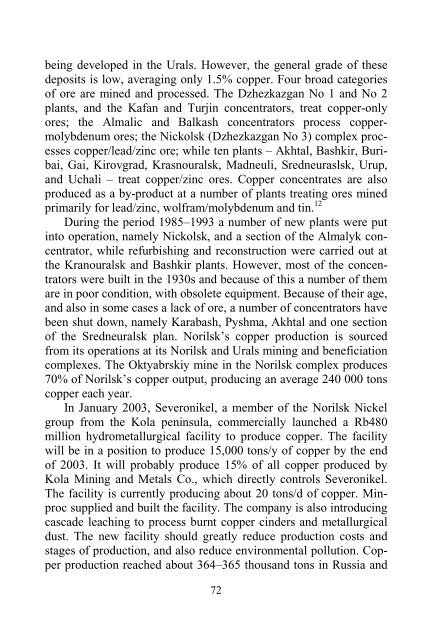L. Fituni, I. Abramova Resource Potential of Africa and Russia's ...
L. Fituni, I. Abramova Resource Potential of Africa and Russia's ...
L. Fituni, I. Abramova Resource Potential of Africa and Russia's ...
Create successful ePaper yourself
Turn your PDF publications into a flip-book with our unique Google optimized e-Paper software.
eing developed in the Urals. However, the general grade <strong>of</strong> these<br />
deposits is low, averaging only 1.5% copper. Four broad categories<br />
<strong>of</strong> ore are mined <strong>and</strong> processed. The Dzhezkazgan No 1 <strong>and</strong> No 2<br />
plants, <strong>and</strong> the Kafan <strong>and</strong> Turjin concentrators, treat copper-only<br />
ores; the Almalic <strong>and</strong> Balkash concentrators process coppermolybdenum<br />
ores; the Nickolsk (Dzhezkazgan No 3) complex processes<br />
copper/lead/zinc ore; while ten plants – Akhtal, Bashkir, Buribai,<br />
Gai, Kirovgrad, Krasnouralsk, Madneuli, Sredneuraslsk, Urup,<br />
<strong>and</strong> Uchali – treat copper/zinc ores. Copper concentrates are also<br />
produced as a by-product at a number <strong>of</strong> plants treating ores mined<br />
primarily for lead/zinc, wolfram/molybdenum <strong>and</strong> tin. 12<br />
During the period 1985–1993 a number <strong>of</strong> new plants were put<br />
into operation, namely Nickolsk, <strong>and</strong> a section <strong>of</strong> the Almalyk concentrator,<br />
while refurbishing <strong>and</strong> reconstruction were carried out at<br />
the Kranouralsk <strong>and</strong> Bashkir plants. However, most <strong>of</strong> the concentrators<br />
were built in the 1930s <strong>and</strong> because <strong>of</strong> this a number <strong>of</strong> them<br />
are in poor condition, with obsolete equipment. Because <strong>of</strong> their age,<br />
<strong>and</strong> also in some cases a lack <strong>of</strong> ore, a number <strong>of</strong> concentrators have<br />
been shut down, namely Karabash, Pyshma, Akhtal <strong>and</strong> one section<br />
<strong>of</strong> the Sredneuralsk plan. Norilsk’s copper production is sourced<br />
from its operations at its Norilsk <strong>and</strong> Urals mining <strong>and</strong> beneficiation<br />
complexes. The Oktyabrskiy mine in the Norilsk complex produces<br />
70% <strong>of</strong> Norilsk’s copper output, producing an average 240 000 tons<br />
copper each year.<br />
In January 2003, Severonikel, a member <strong>of</strong> the Norilsk Nickel<br />
group from the Kola peninsula, commercially launched a Rb480<br />
million hydrometallurgical facility to produce copper. The facility<br />
will be in a position to produce 15,000 tons/y <strong>of</strong> copper by the end<br />
<strong>of</strong> 2003. It will probably produce 15% <strong>of</strong> all copper produced by<br />
Kola Mining <strong>and</strong> Metals Co., which directly controls Severonikel.<br />
The facility is currently producing about 20 tons/d <strong>of</strong> copper. Minproc<br />
supplied <strong>and</strong> built the facility. The company is also introducing<br />
cascade leaching to process burnt copper cinders <strong>and</strong> metallurgical<br />
dust. The new facility should greatly reduce production costs <strong>and</strong><br />
stages <strong>of</strong> production, <strong>and</strong> also reduce environmental pollution. Copper<br />
production reached about 364–365 thous<strong>and</strong> tons in Russia <strong>and</strong><br />
72







